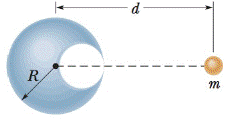
Concept explainers
Figure 13-38 shows a spherical hollow inside a lead sphere of radius R = 4.00 cm; the surface of the hollow passes through the center of the sphere and “touches” the right side of the sphere. The mass of the sphere before hollowing was M = 2.95 kg. With what gravitational force does the hollowed-out lead sphere attract a small sphere of mass m = 0.431 kg that lies at a distance d = 9.00 cm from the center of the lead sphere, on the straight line connecting the centers of the spheres and of the hollow?

Figure 13-38 Problem 13.
Want to see the full answer?
Check out a sample textbook solution
Chapter 13 Solutions
Fundamentals Of Physics
Additional Science Textbook Solutions
The Cosmic Perspective (8th Edition)
Human Biology: Concepts and Current Issues (8th Edition)
Biology: Life on Earth (11th Edition)
Living By Chemistry: First Edition Textbook
Anatomy & Physiology (6th Edition)
Campbell Essential Biology with Physiology (5th Edition)
- No chatgpt pls will upvotearrow_forwardPlease don't use Chatgpt will upvote and give handwritten solutionarrow_forwardThe kinetic energy of a pendulum is greatest Question 20Select one: a. at the top of its swing. b. when its potential energy is greatest. c. at the bottom of its swing. d. when its total energy is greatest.arrow_forward
- Part a-D plarrow_forwardThe figure (Figure 1) shows representations of six thermodynamic states of the same ideal gas sample. Figure 1 of 1 Part A ■Review | Constants Rank the states on the basis of the pressure of the gas sample at each state. Rank pressure from highest to lowest. To rank items as equivalent, overlap them. ▸ View Available Hint(s) highest 0 ☐ ☐ ☐ ☐ ☐ ☐ Reset Help B F A D E The correct ranking cannot be determined. Submit Previous Answers × Incorrect; Try Again; 4 attempts remaining Provide Feedback lowest Next >arrow_forwardPart A m 2πkT ) 3/2 Calculate the integral (v) = f vƒ (v)dv. The function f(v) describing the actual distribution of molecular speeds is called the Maxwell-Boltzmann distribution, = ƒ(v) = 4π (· v²e-mv²/2kT . (Hint: Make the change of variable v² =x and use the tabulated integral foxne integer and a is a positive constant.) Express your answer in terms of the variables T, m, and appropriate constants. -ax dx n! - an+1 where n is a positive (v) = ΕΠΙ ΑΣΦ Submit Previous Answers Request Answer ? × Incorrect; Try Again; 4 attempts remaining Al Study Tools Looking for some guidance? Let's work through a few related practice questions before you go back to the real thing. This won't impact your score, so stop at anytime and ask for clarification whenever you need it. Ready to give it a try? Startarrow_forward
- Starter the rule of significantarrow_forwardPlease solve this problem and give step by step explanations on each step while breaking it down please. Thank you!!arrow_forwardPlease solve this problem and give step by step explanations on each step while breaking it down please. Thank you!!arrow_forward
- No chatgpt plsarrow_forwardNo chatgpt plsarrow_forwardCar A starts from rest at t = 0 and travels along a straight road with a constant acceleration of 6 ft/s^2 until it reaches a speed of 60ft/s. Afterwards it maintains the speed. Also, when t = 0, car B located 6000 ft down the road is traveling towards A at a constant speed of 80 ft/s. Determine the distance traveled by Car A when they pass each other.Write the solution using pen and draw the graph if needed.arrow_forward
 Physics for Scientists and Engineers: Foundations...PhysicsISBN:9781133939146Author:Katz, Debora M.Publisher:Cengage Learning
Physics for Scientists and Engineers: Foundations...PhysicsISBN:9781133939146Author:Katz, Debora M.Publisher:Cengage Learning Classical Dynamics of Particles and SystemsPhysicsISBN:9780534408961Author:Stephen T. Thornton, Jerry B. MarionPublisher:Cengage Learning
Classical Dynamics of Particles and SystemsPhysicsISBN:9780534408961Author:Stephen T. Thornton, Jerry B. MarionPublisher:Cengage Learning Principles of Physics: A Calculus-Based TextPhysicsISBN:9781133104261Author:Raymond A. Serway, John W. JewettPublisher:Cengage Learning
Principles of Physics: A Calculus-Based TextPhysicsISBN:9781133104261Author:Raymond A. Serway, John W. JewettPublisher:Cengage Learning University Physics Volume 1PhysicsISBN:9781938168277Author:William Moebs, Samuel J. Ling, Jeff SannyPublisher:OpenStax - Rice University
University Physics Volume 1PhysicsISBN:9781938168277Author:William Moebs, Samuel J. Ling, Jeff SannyPublisher:OpenStax - Rice University Glencoe Physics: Principles and Problems, Student...PhysicsISBN:9780078807213Author:Paul W. ZitzewitzPublisher:Glencoe/McGraw-Hill
Glencoe Physics: Principles and Problems, Student...PhysicsISBN:9780078807213Author:Paul W. ZitzewitzPublisher:Glencoe/McGraw-Hill Physics for Scientists and Engineers, Technology ...PhysicsISBN:9781305116399Author:Raymond A. Serway, John W. JewettPublisher:Cengage Learning
Physics for Scientists and Engineers, Technology ...PhysicsISBN:9781305116399Author:Raymond A. Serway, John W. JewettPublisher:Cengage Learning





